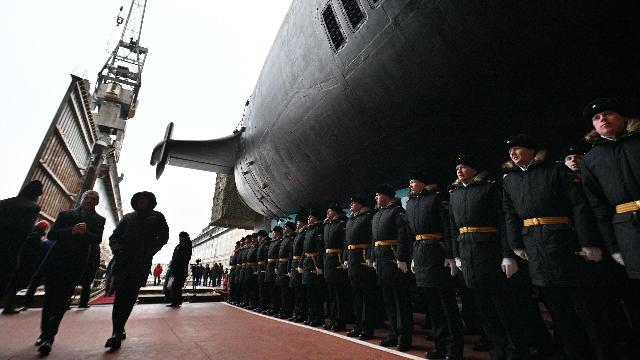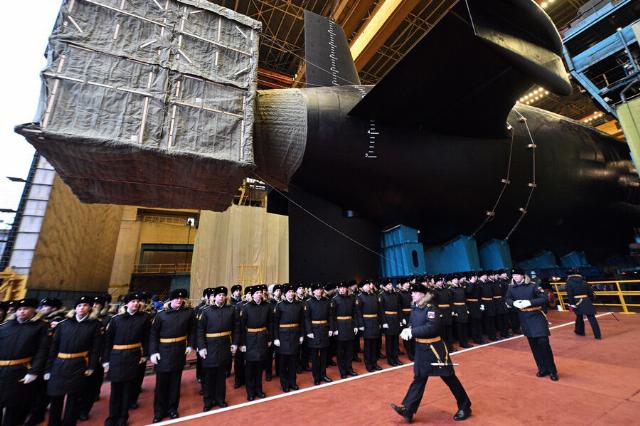CHIP: the terrifying Russian submarine "Prince Pozharsky" will change the balance of power in the world
Russia's new weapons, which it plans to deploy in the Arctic, could change the balance of power in the world, the Polish edition of CHIP writes. The publication notes that the Russian submarine "Prince Pozharsky" "sows terror." Why Poland was afraid of the Russian submarine and why it is unique - in the material of the military observer "Gazeta.Ru", retired Colonel Mikhail Khodarenka.
"Russia is introducing a colossus into the game that not only sows terror, but can also change the balance of power in the world," CHIP writes about the 955A Knyaz Pozharsky (K-555) strategic missile submarine.
The author of the text, Polish journalist Mateusz Lyson, did not spare epithets and emotions when describing the Russian nuclear missile submarine. According to him, "the Russians will replenish the fleet with a ship whose armament will shake the world."
Meanwhile, this is the eighth submarine of the Borey project 955 and the fifth, which is being built according to the upgraded Borey-A project 955A. So it would be advisable to apply the delights and horrors described by the Polish journalist to the lead ship of this project (K-535 Yuri Dolgoruky), which was commissioned into the Russian naval strategic nuclear forces 12 years ago. Currently, this submarine is already undergoing scheduled repairs, which are scheduled to be completed in 2027.
As for the PKK CH K-555 Knyaz Pozharsky, which made such a strong but generally somewhat belated impression on Mateusz Lyson, this ship was designed by JSC Central Design Bureau of Marine Technology Rubin and belongs to the fourth generation of Russian missile submarines.
The Borey-A strategic missile submarine has improved performance in a number of shipboard systems compared to its predecessors, the Borey project submarines.
The fourth generation of submarines
In the United States, fourth-generation nuclear submarines include the multipurpose submarines of the Seawolf projects (3 units were commissioned in 1997-2004, the project was closed) and Virginia (19 units were commissioned in 2004-2020; it is planned to build up to 30 submarines of this type).
In Russia, fourth-generation submarines are represented by submarines of projects 885/885M (Yasen) and 955/955A "Borey"/"Borey-A".
The laying of the ship "Prince Pozharsky" took place on December 23, 2016 on the slipway of the Joint-Stock Company "Production Association Northern Machine-Building Enterprise (Sevmash)". On February 3, 2024, the submarine was launched. The transfer of the PKK CH K-555 "Prince Pozharsky" to the Northern Fleet is scheduled for June 2025.
 |
| The ceremony of launching the nuclear submarine missile cruiser "Prince Pozharsky" of the Borey-A project at the Sevmash plant in Severodvinsk. |
| Source: © RIA Novosti / Kirill Zykov |
The 995A strategic missile submarine project has proven to be successful and has good prospects for modernization, and therefore the series can be continued after all the currently contracted submarines are built. The ninth and tenth Boreas will be delivered to the fleet by 2030. At about the same time, the strategic missile submarines project (PKK CH) 667BDR (Kalmar) and 667BDRM (Dolphin) will be withdrawn from the Russian Strategic Nuclear Forces and sent for disposal.
The total throwable weight of the rocket is 1,150 kg. The maximum launch range is 8,000 km, which is enough to hit almost all targets in the United States. During earlier launches, the rocket covered a distance of 9.1 thousand km.
In addition to missiles, the submarine has eight bow 533-mm torpedo tubes (maximum ammunition of 40 torpedoes, rocket-torpedoes or self-transporting mines). The USET-80 and UGST torpedoes, as well as Waterfall missiles can be used from the boat.
There are also six disposable, non-rechargeable 533-mm RAPS-324 "Shlagbaum" launchers for launching sonar countermeasures, which are located in the superstructure (similar to the boats of Project 971). The ammunition consists of six self-propelled sonar countermeasures devices: MG-104 "Throw" or MG-114 "Beryl".
The newest missile submarines of the Borey project will form the basis of the Russian Navy's naval strategic nuclear forces in the near future.
And who are the competitors?
The process of generational change of nuclear submarines with ballistic missiles is gaining momentum in the United States. Currently, the only type of strategic missile carriers in service with the US Navy are 14 Ohio-class nuclear submarines built in the 1980s and 1990s. In the near future, they are to be replaced by 12 Columbia-class submarines.
"Columbia" can be safely called a nuclear submarine of the USA of the 21st century. The submarine has been designed to serve for 42 years. The nuclear reactors designed for these boats are designed for this cycle.
 |
| The project of the American Columbia-class nuclear submarine. |
| Source: © Photo : Public Domain |
The Columbia will receive an electric propulsion system, which will ensure greater boat stealth compared to previous Ohio-class boats, which already have a reputation for being very secretive. Instead of the 24 launch silos at Ohio, Columbia will be equipped with 16 launch silos.
In September 2020, the full-scale construction of the first ship of this project (SSBN 826) started. In September 2023, it was decided that the construction of the second building (SSBN 827) should begin in fiscal year 2024. The $9.9 billion budget request for fiscal year 2025 reflects a $3.7 billion increase in financing, due to an increase in the production base and preliminary costs for the purchase of submarines for fiscal year 2026.
The United Kingdom is also engaged in the modernization of its naval strategic forces. Back in 2016, the parliamentarians of Foggy Albion approved a program for the modernization of strategic nuclear forces and the construction of four new nuclear submarines with ballistic missiles. In 2016, the lead PKK CH of a promising project called Dreadnought was laid in the United Kingdom. It is also planned, but construction of three similar ships has not yet begun.
France's strategic nuclear forces are represented by four CH-type Triomphant PKKS, each carrying 16 nationally developed M45 or M51 missiles. They were introduced into the fleet between 1997 and 2010. The possibility of replacing them is still being considered.
Beijing has also joined this competition. In the early 2020s, China began construction of a new generation of nuclear-powered strategic missile carriers, the Type 096. The lead submarine is to be handed over to the PLA Navy by 2030. It can be armed with 16 to 24 ballistic missiles.
The leading countries of the world still consider naval strategic nuclear forces as one of the main signs of a state's military might.
Mikhail Khodarenok





